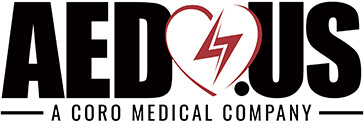While sudden cardiac arrest (SCA) most commonly occurs in adults, children and infants can be affected as well. According to the Children’s Hospital of Philadelphia, roughly 2,000 children and adolescents in the United States lose their lives each year due to SCA. It accounts for 3-5% of deaths in children 5-19 years old, and 10-15% of unexpected deaths in infants. With those figures in mind, it’s not surprising that one of the most common questions we hear is “Can you use an AED on infants and children?” Fortunately, the answer is yes, and we’ll cover best practices as well as child and infant AED pad placement in this guide so you’re well-equipped to help your loved one in the event of an emergency.
Can an AED be Used on an Infant or Child?
In short, the answer is yes, you can use an AED on an infant or child. Sudden cardiac arrest is caused by an electrical issue in the heart, and an AED is designed to analyze that issue and, if possible, deliver an electrical shock to restore the heart’s normal rhythm. In most instances, AEDs have the ability to deliver a lower shock level when used on an infant or child. How this is done depends on the model you have:
- Pediatric Pads: Many models have specific pads which should be used for children and infants. To find the right AED pads for your machine, head over to our AED Pad Guide.
- Infant/Child Key: Some AEDs (e.g. Philips Heartstart FRX) rely on a physical key to deliver an appropriate shock to the patient. Inserting the key into a slot in the machine will adjust the instructions provided and lower the therapy level.
- Toggle Switch: Other models such as the LIFEPAK CR2 and the ZOLL AED 3 have a built in mode enabling the bystander to lower the joule output of the device. Having this feature built in eliminates the need to buy special pediatric pads or a physical key, ensuring you’re always prepared in the event of an emergency.
If you’re in the market for a defibrillator and want to ensure the model you use has pediatric capability, we’ve compiled a list of AEDs for children, all of which fall into one of the three categories above and can be relied upon when you need them most.
Can You Use Adult AED Pads on a Child or Infant?
As mentioned above, the answer to this question depends. Models with a dedicated pediatric mode (e.g. ZOLL AED 3 and LIFEPAK CR20) or with an optional pediatric key (e.g. Heartstart FRX) allow you to provide treatment to a child or infant using the same pads you would use on an adult. For all other models, however, you must purchase dedicated pediatric AED pads designed to work with your specific machine.
Infant AED Pad Placement
For infants under the age of one, place one of the pads in the center of their chest and the other in the middle of their back between the shoulder blades. Most packaging for pads will also include an illustration, so you can refer to that if needed.
Child AED Pad Placement
When attending to a child weighing under 55 pounds and up to eight years old, place one pad on the upper right portion of the child’s chest and the other on the lower left portion of their chest. Ensure, however, that there is enough space to place both pads properly without them touching, as this could interfere with the machine’s ability to deliver treatment. If there is not enough space, follow the placement guidelines for infants with one in the middle of the chest and the other in the middle of their back between their shoulder blades.
Closing Thoughts
Now that you know best practices for using an AED on infants and children, you should be better prepared to help a loved one in the event of an emergency. If you have any questions about which AED is best for your needs or need help finding a specific product, our customer service team is always available to assist you.
Sources
- Children’s Hospital of Philadelphia. “Sudden Cardiac Arrest.” https://www.heart.org/en. 26 January 2021.
 Written by Blaire Czarniecki
Written by Blaire Czarniecki
Customer Service Director
Fact checked by Phillip Woods, BA, NREMT-P, FP-C
Blaire attended the University of Tennessee where she graduated with a Bachelor of Science in Human Ecology- Child and Family Studies. She has been in the Automated External Defibrillator (AED) industry for over eight years and is the Director of Customer Service for Coro Medical. Blaire is also an American Red Cross-certified CPR/AED/First Aid Instructor, highly trained by each manufacturer on their specific AEDs, and knowledgeable regarding ALL State AED regulations and legislation.
“I know that every day I come to work, I am playing a part in saving someone’s life. I am passionate about these devices and am always looking for new and innovative ways to spread awareness and knowledge about Sudden Cardiac Arrest (SCA). I look forward to the day when everywhere I go, I will see an AED—when SCA will no longer take any lives.”
Last updated October 12, 2020





